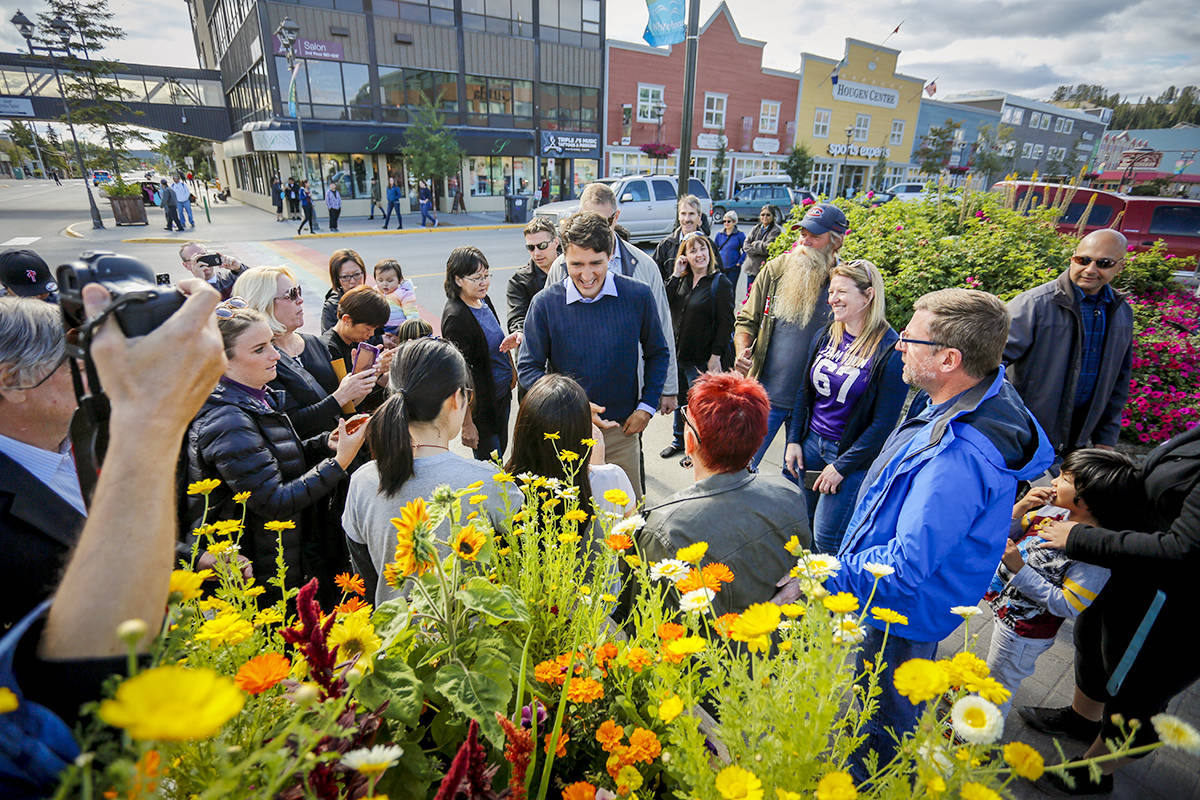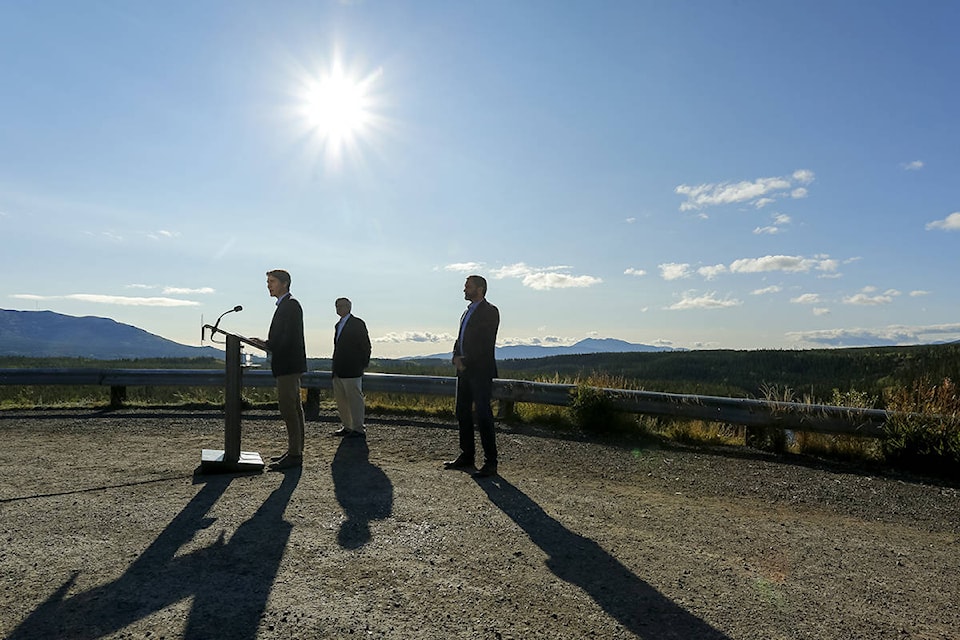The federal and territorial governments are spending about $360 million as part of a nearly half-billion dollar project to improve road access to two mining regions in the territory.
Prime Minister Justin Trudeau made the announcement Sept. 2 as part of a 24-hour visit to the Yukon.
The federal government is willing to contribute up to $247.3 million, Trudeau said. The territorial government has agreed to pitch in up to $112.8 million. Industry is expected to add about $108 million.
Known as the Resource Gateway Project, the money will be spent on roads and bridges in the Dawson range in central Yukon and the Nahanni Range Road in the southeast.
In all, about 650 kilometres of road will be upgraded. Numerous bridges, culverts, and stream crossings will also be replaced.
In the Dawson range, four public road systems will get repairs. The Nahanni Range Road will get upgrades from its junction with the Campbell Highway to the border between Yukon and the Northwest Territories.
“Building infrastructure is one of the best way to create opportunities and long term growth in a sustainable way for communities, and we will do that,” Trudeau said, standing alongside Yukon Premier Sandy Silver and Liberal MP Larry Bagnell.
If everything goes as planned, some construction could start in 2018, said Allan Nixon, assistant deputy minister for the Yukon Department of Highways and Public Works. That’s a year later than what was in the original proposal sent to Ottawa lastyear.
The whole project is expected to take eight years, according to the proposal.
“The program is scheduled to end in 2024-25 and we’re hopeful that we can get some extension on that,” Nixon said.
Money will come from the federal government as work is completed, Nixon said
“You don’t actually get money until you spend it. The key here is the commitment that they’ve made to fund it.”
Three major potential mines, Coffee, Selwyn and Casino, could benefit from the improvements. To date, none of them have made it through the territory’s environmental and socio-economic assessment process.
Lewis Rifkind, the mining analyist for the Yukon Conservation Society, is critical of the governments’ decision to fund these roads, calling the project “taxpayer-funded infrastructure for private corporations.”
“Where do we draw the line between federal dollars and infrastructure and just basically corporate welfare?”
Mining companies are slated to contribute about $108 million to the project. Western Copper and Gold and Goldcorp, the owners of the Casino the Coffee projects respectively, will be paying for 70 per cent of the cost for two controlled access roads totheir respective mine sites. The remaining 30 per cent will come from the territorial government.
If the mines don’t come up with their portion of the money territorial government would not pay its portion towards the access roads, Nixon said.
The rest of the road upgrades, including to the Goldfield Roads, the Nahanni Range Road, the Freegold Road and to create a new Carmacks bypass, will happen with or without the mines being approved, Nixon said.
“We think there’s still value there and the federal government does as well because they’ve agreed to the proposal as we wrote it.”
The community of Carmacks has been talking for years about building a bypass to direct vehicles around the community, he said.
“There’s been concerns from the community of Carmacks about industrial traffic coming … right through the community.”
Samson Hartland, the executive director of the Yukon Chamber of Mines, said investing in infrastructure is about more than those major projects.
“There are plenty of other low-level, grassroots, exploration projects that have significant potential to become operating mines one day, decades down the road.”
He called the investment “visionary.”
“This is about unlocking Yukon’s mineral potential. This is about the dozens of companies that operate within those regions and that have opportunities to bring mines online. Not potentially part of this generation but part of future generations as well.”
Paul West-Sells, the president of Western Copper and Gold, said people other than miners use the public roads.
“Putting a better road and a safer road into that area I think makes sense regardless of any mining projects going forward,” he said.
Silver said the work will not start until agreements are signed with the various First Nations that have traditional territory in the regions.
“It’s a conversation about jobs, it’s a conversation about prosperity,” he said. “It’s a conversation about making sure that our communities in the Yukon are more resilient tomorrow for our next generation than they are today.”
The agreements with First Nations will be signed before a funding agreement is officially signed with Ottawa, Nixon said.
“We’ve had preliminary discussions with First Nations but you need to get down into the meat and into the details of the agreements and that’s where the discussions need to go next.”
Liard First Nation Chief George Morgan said he expects to negotiate an impact benefit agreement for the Kaska to cover the portion of the project that will run through Kaska traditional territory.
He said the announcement is good news for the territory. “I really find this to be something to celebrate for the Yukon.”
Little Salmon Carmacks First Nation Chief Russell Blackjack said he’s hoping the project will benefit the economy in Carmacks and the Yukon as a whole while still protecting wildlife in the area.
“We have to make sure that they’re protected and the environment’s protected,” Blackjack said. “If we can do that, the whole Yukon will benefit.”
Rifkind said he’s concerned that spending millions of dollars on roads could mean government officials are less likely to speak up against the mining projects as they make their way through the assessment process.
“Would they have the gumption to say, no, do not approve this project even though we’ve pumped $250 million into the access road, the technology being used on the mine or the environmental impacts of the mine are just too negative?”
Both the current government and the former Yukon Party government lobbied Ottawa to fund the plan. Yukon Party MLA Scott Kent said in a statement he’s glad the project was approved.
Hundreds attend Trudeau Whitehorse meet-and-greet
Trudeaumania swept the Kwanlin Dün Cultural Centre Friday evening as Prime Minister Justin Trudeau marked his first visit to Whitehorse since being elected to office in 2015 with an informal meet-and-greet.
Welcomed by Kwanlin Dün First Nation elder William Carlick, Ta’an Kwäch’än Chief Kristina Kane and MP Larry Bagnell, Trudeau made a brief speech extolling the North to the hundreds gathered on the KDCC back lawn before stepping into, and beingmobbed by, the camera-and-smartphone-wielding crowd.
The prime minister did not take any questions from the press or make any statements of political importance Friday, but posed for photos, held babies, signed autographs and hugged attendees for close to an hour and a half. Some shrieked withexcitement as they squeezed their way out of the throng, devices displaying prized selfies held tightly in hand.
“I thought I was going to die in there,” one teen said gleefully after breaking free from the congregation.
“I just got a photo with him. He smells so good,” said another.
Bagnell emerged from the crowd at one point saying, “This many people never show up for me.”
As time went on, some gave up on trying to reach Trudeau, instead resorting to taking photos of the mass surrounding him. Others took advantage of the free s’mores and bannock being passed around, while a few danced to live music by Hank Karr andthe Canucks.
Trudeau posed for pictures all the while as he slowly made his way to the front the KDCC, surrounded by a team of security personnel that allowed one last photo on the driveway before escorting him into one of an idling convoy of black, tinted-windowSUVs.
Then, to a round of applause and handful of waves, the prime minister and company drove off.
Contact Ashley Joannou at ashleyj@yukon-news.com and Jackie Hong at jackie.hong@yukon-news.com

